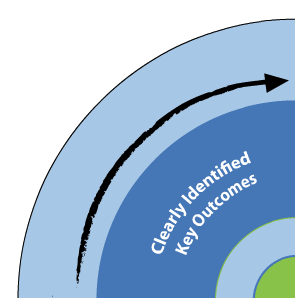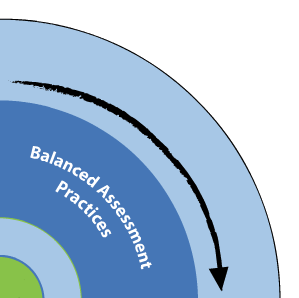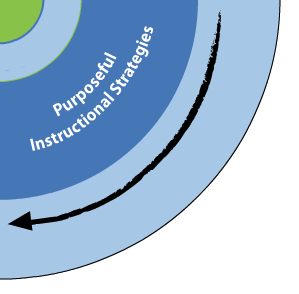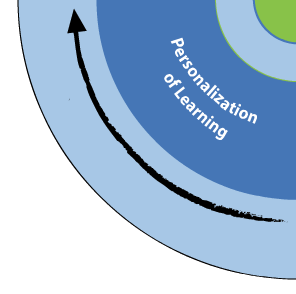PHonics
Page Navigation
(Click to jump to section)
| Brief Explanation | Research | Characteristics of a Skilled Reader | Clearly Identified Key Outcomes | Balanced Assessment Practices | Purposeful Instructional Strategies | Personalization of Learning |
Brief Explanation
Phonics is the connection between individual or groups of letters of the written language and sounds.
Research
- Phonics is the next logical sequence of reading instruction following phonological awareness. Phonics is the ability to identify that there is a relationship between the individual sounds (phonemes) of the spoken language and the letters (graphemes) of the written language. (Tankersley, 2003).
- This involves helping beginning readers learn how sounds are linked to letters and letter combinations in the written language, and teaches predictable patterns. Students must learn that there are systematic and predictable relationships between letter combinations and spoken sound (Tankersley, 2003). Phonics is integral in the development of word attack skills, and is best practiced by reading.
Characteristics of a Skilled Reader
With
Increasing
Sophistication
- Recognize that sounds (phonemes) can be represented by letters (graphemes), or groups of letters (graphemes).
- Recognize initial, medial, and final sounds represented within printed words.
- Identify long and short vowel sounds represented within printed words.
- Blend sounds represented by letters and groups of letters into phonetically regular one and two syllable words.
- Decode phonetically regular one and two syllable words.
- Break unknown written words into syllables and blend the parts together to form words.
- Break difficult, long words into meaningful parts such as prefixes, suffixes, and roots that can help them to decode and understand them.
- Decode polysyllabic words in higher-level reading materials and content areas.

Clearly Identified Key Outcomes
Use your programs of study for curriculum outcomes related to phonics.
Please refer to CESD’s Essential Outcomes work if you are using the previous Alberta Curriculum (Grade 7+).
Here is the New Alberta ELAL Curriculum, from the New Learn Alberta website, laid out like a scope and sequence.

Balanced Assessment Practices
- Students are able to spell a number of words within a group of rhyming words, beginning with one word as a cue. E.g. rat
- Students are able to generate word families given a base word. E.g. base word “joy” belongs to the word family including “enjoy”, “joyous”, “joyful”, “joyless”.
- Students are able to apply language rules as they sound words out. E.g. “e” at the end of a word usually makes the vowel say its name.
- Students can apply spellings initially through how the word sounds, then as writing matures, are able to recall certain words by sight. E.g. flight – recognizing that some letters don’t always represent a sound.
- Assessments:
- CC3 – Alberta Education
- Beginning Decoding Skills– Farrell
- Advanced Decoding Skills – Farrell
- Quick Phonics Screener – Hasbrouck & Parker
- EICS Phonological Awareness Assessment Tool
- Formative assessment should be ongoing and be embedded throughout lessons to inform teaching.

Purposeful Instructional Strategies
PRE
- It is essential that a school rely on common language (which may lead to one resource) so that the students are taught phonics in a consistent manner.
- Students should be taught how to:
- Understand how to look at and track print (left to right)
- Identify which letter (s) make which sounds – sound/symbol correspondence.
- Identify letters by beginning, middle and end positions in words.
- Identify vowel patterns (digraphs) (e.g. ch, sh), and (dipthongs) (e.g. oi, ou)
- Identify predictable word patterns in our language. (early reader eg. – groups of rhyming words: cat, mat, hat, bat, etc.)
- Identify a sound (s), and then apply it in their reading (eg. ai, ay, eigh, ae, ey, eh?)
- Identify a sound, blends and sound combinations in print
- Notice the placement of the sounds in the mouth, tongue positions for example
- Understand affixes (suffixes and prefixes)
- Teach students strategies to sound out unknown words
- Read and write daily, and frequently
- Ensure students are able to practice their sounds in print following a lesson, so that the lesson has meaning within context. This allows the child to decode (apply phonic rules and strategies) the word, which then starts linking to comprehension.
DURING
-
- Rhyme – have students generate as many rhyming words as they can beginning with a simple groups of rhyming words eg. can, ran, etc.
- Move from generating simple word combinations to complex eg. from “at “ to “an” to “ank” to “ain” (eg. Elkonin boxes, word boxes, Making Words, Making Big Words, Four Blocks)
- Always teach the words within a context to aid comprehension
- Developed readers segment affixes from words, or learn to find words within words
- Frequently expose students to high frequency word lists
- Decodable text to provide support/practice for specific phonetic areas of instruction.
- Read and write daily, and frequently.
- Adequate time should be provided to the child to master the sounds, beginning with simpler to complex, in a systematic order (eg. Jolly Phonics is a resource that provides a systematic approach to phonics instruction. Mastery is essential before moving on).
- Utilize research based tools, such as Heggerty, and the UFLI.
POST
- Letter Sound Recognition
- Guided Reading Resources – levelled and decodable literature
- Daily Reading and Writing – self editing – begins with a form of the word, and as exposure increases, the taught words become automatic eg. spgdi – spugeddi – spaghetti
- Increasing fluency when reading
- Running Records
- Listen to students read
- Formative assessment should be ongoing and be embedded throughout lessons to inform teaching.
RESOURCES TO SUPPORT OVERALL DEVELOPMENT
- Seeing rhyming words in text, eg. Dr. Seuss Books
- Jolly Phonics
- Word Matters: Teaching Phonics and Spelling in the Reading/Writing Classroom (Fountas and Pinnell, 1998)
- SOUND walls (focus on word families), and subject specific word lists in content areas
- Sound Walls (Mrs. Winter Bliss)
- UFLI Toolbox






Personalization of Learning
- As soon as it is identified that a student is struggling with identifying sounds, intervention is required. This gap is often easily identifiable during the Kindergarten year, and intervention at that point can be very effective.
- When teaching students letter sounds, one should aim for automaticity with letter and sound recognition
- Instructional strategies should be chosen to match the learning needs of each student.
- Contact your learning support team for support with students who have more specialized needs, gaps in their learning, or are requiring more challenge.
- Use the results of norm-referenced Level A assessments to inform teaching practice and to meet students’ needs